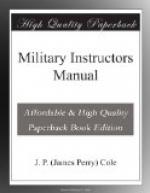DUTIES:
(6, 42, 104, 229, 231-233, 244,
245-257, 319, 375, 550, i.d.r.)
Controls the fire of his platoon
and in his fire orders.
1. Receives his orders from
the company commander.
2. If necessary, may indicate
the fire position that has been
ordered.
3. Announces sight setting.
4. Points out designated target
to his platoon, if practicable,
otherwise to his
corporals only, or
5. When the target cannot be
seen, indicates an aiming target. (247
and 251, i.d.r.,
call this an aiming “point”, but the occasions
upon which infantry
would use an aiming “point” are so rare
that
it is believed
aiming “target” is a more accurate term
as it
includes both
point and line.)
6. Assigns target so as to
insure that the entire front or sector
given him by the
company commander will be covered with fire.
7. Gives class of fire.
8. Announces rate of fire.
9. If commanding a flank platoon,
details a man to watch for
signals from the
combat patrols.
10. When his Corporals have signaled
that their squads are ready to
fire, signals
the Captain by looking toward him and holding up
his hand.
11. When Captain signals a “commence
firing”, repeats same to the
corporals.
THEREAFTER:
1. Observes for fire effect.
2. When platoon is not firing,
insures that the front assigned is
kept under constant
observation for any appearance of the enemy
or any change
of position.
3. Changes sight-setting of
his platoon when necessary.
4. Regulates rate of fire.
5. Increases rate of fire when
large and distinct targets appear
and decreases
it when the target becomes small and indistinct.
6. Prevents decrease in rate
of fire when—
(1) Changing sight-setting,
(2) Preparing
for rushes,
(3) Fixing bayonets,
(4) Transmitting
firing data to supports,
(5) Distributing
ammunition.
7. Increases the rate of fire
to cover the advance of adjacent
units. For
this purpose progress and movements of adjoining
units are kept
under observation.
8. Maintains direction of advance
of his platoon in rushing, so as
not to blanket
fire of adjacent units.
9. Is on the alert for Captain’s
commands or signals, for this
purpose he may
use his platoon guide.
10. May use his platoon guide to
observe adjoining units.
11. Must understand all signals.
12. Leads his platoon in advancing
and charging.
13. Prevents changing fire to unauthorized
targets.
14. Insures distribution of ammunition
brought up from the rear and
the collection
and distribution of same from the dead and
wounded. (540,
i.d.r.).
15. In coming up with re-enforcements,




